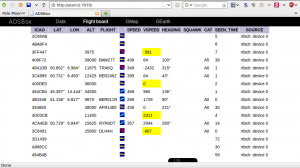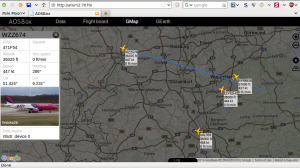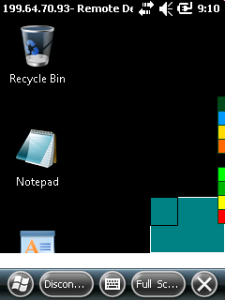Archive for the ‘Programming’ Category.
February 17, 2016, 18:44
Last week I got my rtl-sdr usb dongle by http://www.rtl-sdr.com/buy-rtl-sdr-dvb-t-dongles/. I ordered the “RTL-SDR Blog R820T2 RTL2832U 1PPM TCXO SMA Software Defined Radio with 2x Telescopic Antennas”.
Installation of the driver on the Debian Jessie system worked flawless I also first insalled and tested on a Raspberry Pi 2 B without hassles. But as I wanted to use the dongle alos as a radio scanner, I went over two the larger system.
After trying different Linux compatible software for Radio reception I went over to ADS reception. First I started with dump1090, which runs fine without any problems but I missed the flightradar24.com similar display on a google map and airplane details. So I tried ADSbox. After getting the sqlite3 source and placing it nearby the adsbox directory, the compilation went fine and I now can watch some airplanes around my location.

and, some time later (therefor different planes):

Please know that the noise made by these airplanes is loud, even if they are 30000ft high and some kilometres away.
Now, I know which planes are there making the noise and where they are. Frustrating…I can not do anything against the noise but going indoor.
November 25, 2015, 20:29
Nach langem hin und her und dem Lesen von vielen unvollständigen und falschen Posts (manche User können noch nicht mal richtig Texte in Posts kopieren oder schreiben irgendwas aus dem Kopf) habe ich meine eMail Warnungen für Batterien jetzt fertig. Ach ja, an alle fhem Forum Poster die Variablen benutzen: wenn es denn keine global definierten Variablen sind muss IMMER ein ‘my’ davor! Wenn Du als User also irgenwo fhem Perl Code mit einer Funktion siehst und die Variablen haben kein my davor, dann wird der wahrscheinlich so nicht funktionieren.
Im Grunde ist es ganz einfach. Man darf halt nur nicht alles ungeprüft übernehmen. Antworten zu Hilferufen (von Anfängern) im FHEM Forum sollten auch nicht mit “Lern erst mal Perl” benatwortet werden. Zudem kommt, dass die Syntax der Anweisungen mal FHEM und mal Perl ist. Dann noch der Unterschied, ob man direkt in die fhem.cfg schreibt oder über die Web Oberfläche Kommandos absetzt oder DEF Eingaben vornimmt.
Lange Rede kurzer Sinn. Hier die entsprechenden fhem.cfg Zeilen Original aus meinem laufenden fhem Server: Continue reading ‘FHEM Batteriewarnung per eMail’ »
November 9, 2015, 18:57
I already posted one article about using injectDLL, one about subclassing a foreign window. This time injectDLL is used to start and stop an application when another app is started. Remember that every DLL listed inside the MULTI_SZ registry key HKLM\System\Kernel\injectDLL is loaded into every process.
I would like to add some battery and wifi indicator to a full screen Remote Desktop Mobile (RDM) session. There are two specialized applications that display a small bar graph on the right of the screen, one for the battery level and one for the WiFi RSSI.

The upper right one is for the WLAN RSSI and the lower bar shows the battery charge level.
As these apps should only add there display when RDM ist started, I added them to an injectDLL.
Continue reading ‘Mobile Development – Start apps with another using injectDLL’ »
November 5, 2015, 21:07
Manchmal möchte man vielleicht ein serielles Gerät (device) statt über USB oder RS232 entfernt vom FHEM Server betreiben. Zum Beispiel einen FhemDuino oder SignalDuino oder RFXCOM. Dies ist nun mit einem ESP-01 oder einem anderen ESP Modul basierend auf dem ESP-8266 einfach möglich.
Der ESP-8266 bietet WLAN Anbindung, zwei oder mehr GPIO Ein- und Ausgänge und eine serielle Schnittstelle. Mit Hilfe geeigneter Software kann man einen ESP-8266 als WiFi-Serial Bridge einsetzen. Das heisst, alles was seriell rein oder raus geht wird über WiFi und ein geeignetes Protokol zum oder vom FHEM Server übertragen.
In meinem Beispiel betreibe ich einen Arduino Nano mit der SignalDuino Software und einem ESP-01 mit der JeeLink Software esp-link an meinem FHEM Server.
Continue reading ‘FHEM – serielle Geräte über WiFi anbinden’ »







 http://www.led-mg.de
http://www.led-mg.de